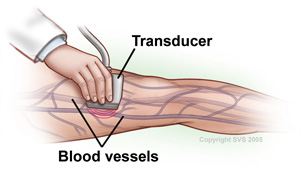
Leg Pain
Symptoms
Why should I be concerned about leg pain?
There are many causes for leg pain, but one of the main reasons is poor circulation, or Peripheral Artery Disease (P.A.D.), which can lead to numerous health conditions or worsen those you already have. P.A.D. occurs when plaque builds up in the artery walls and reduces or stops the blood from flowing. Plaque is a sticky substance of cholesterol, calcium and fibrous tissue. Plaque cause arteries to become narrow and stiff, a process called atherosclerosis—also known as hardening of the arteries.
The reduced blood flow results in less oxygen being delivered to your legs, which can hinder the body’s ability to function normally. Poor circulation that is not addressed can develop into a serious disorder, and can lead to amputations, strokes and heart attacks.

Who is at Risk?
Individuals with any of the following risk factors should see their physician if they experience leg pain:
- Over 50 years of age
- Diabetes
- High blood pressure
- High cholesterol level
- Smoking (current or past)
- History of heart disease or vascular disease
Symptoms of Poor Circulation that Cause Leg Pain
- Leg pain with walking or at rest
- Painful cramping of the muscles in the hip, thigh, or calf after activity, which is also called claudication
- Leg numbness or weakness
- Coldness in the lower leg or foot, compared with other parts of the body
- A sore, poorly healing wound or ulcer on the toe, foot, or leg
- Change in skin color or shiny skin on the legs
- Hair loss or slower hair growth on the feet and legs
- Slower toenail growth
- No pulse or a weak pulse in the legs or feet
How Can I Prevent Poor Circulation in My Legs?
There is a lot you can do to prevent poor circulation in your legs. In addition to following your doctor’s advice, you can make lifestyle changes that will greatly reduce your risk factors for poor circulation.
- Smoking cessation not only improves blood circulation but also prevents a host of other diseases, including diabetes.
- Regular exercise — at least 30 minutes a day — will help tremendously.
- Eating a healthy diet with fruits and vegetables is also important for good health, and helps the body function normally.
Diagnosing Leg Pain

Ankle-Brachial Index (ABI)
You may be given an Ankle-Brachial Index (ABI) test to compare the blood pressure in your ankle and your arm, which are normally the same. If the blood pressure in your ankle is significantly lower, that could be a sign of narrowing leg arteries.
Doppler Ultrasound
Ultrasound may be used to determine which arteries are blocked. Often, this is used to find the specific location and pattern of any blockages which helps specifically identify the best way to correct the problem.
Testing can be done in the PVA Vascular Lab.

Treatments
Treatment options vary by patient and the severity of the disease but can include simple things such as exercise, changes to your diet, or medication. Smoking should be avoided entirely. If there is little improvement through these efforts, angioplasty or stenting may be performed to improve circulation. For more advanced cases, surgical bypass or endarterectomy may be necessary to improve blood flow. In some cases, a combination of open surgical technique and endovascular technique are used. Each patient should have their anatomy, symptoms and risks carefully analyzed to create a individualized treatment plan.

Caring for Your Legs
Foot care is especially important for those with poor circulation. Some ways of better caring for your feet include:
- Wearing proper shoes to avoid placing undue pressure on certain areas of the foot and to prevent injury
- Practicing proper foot hygiene and taking gentle care of corns and calluses
- Inspecting your feet daily
- Seeking help from your doctor for any wounds, sores, or infections on the foot that won’t heal.
For more information about Foot Care Dos and Don’ts click the button below.











